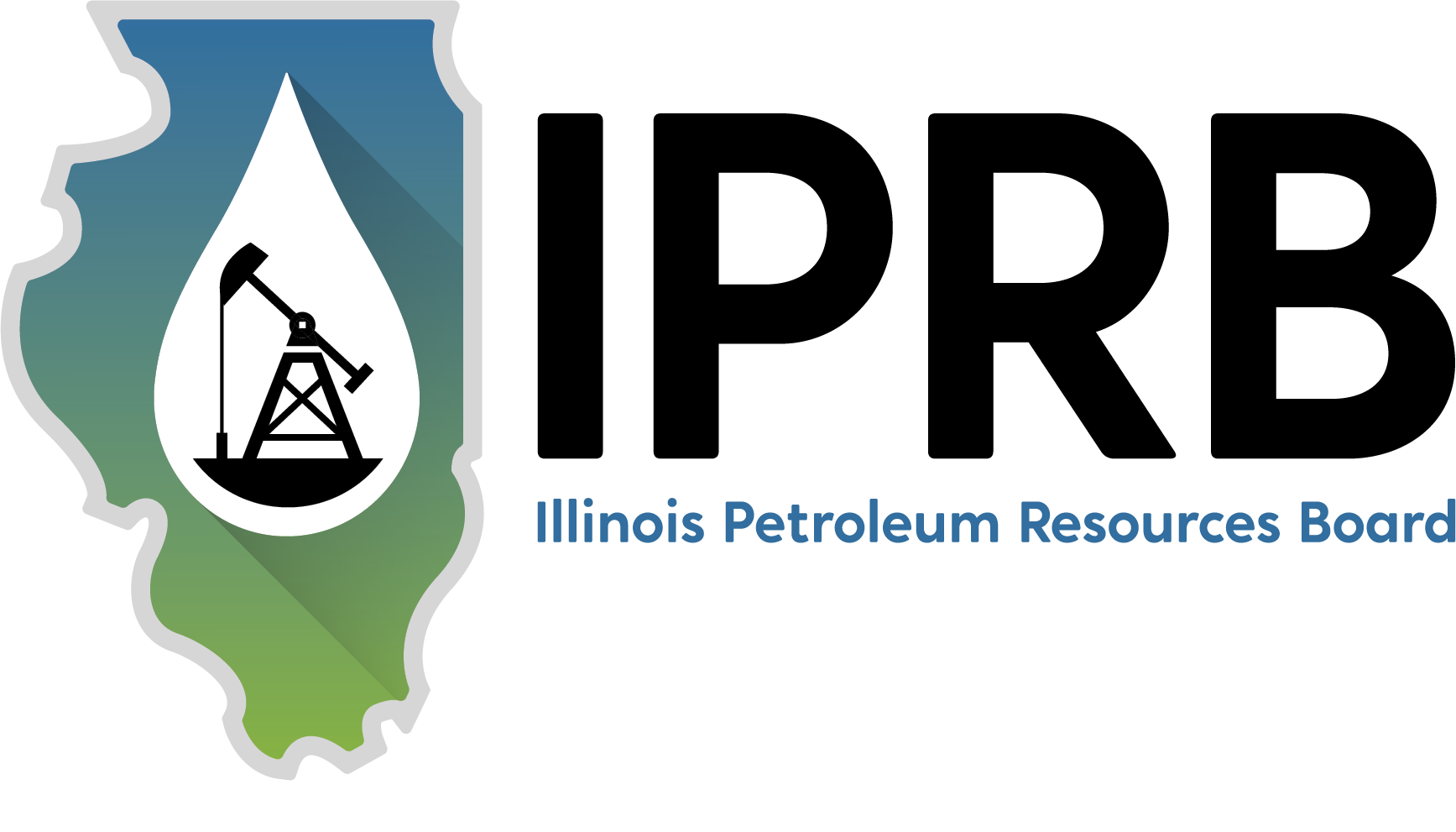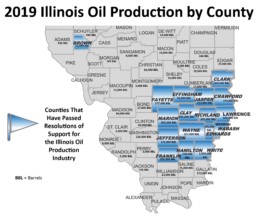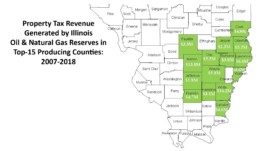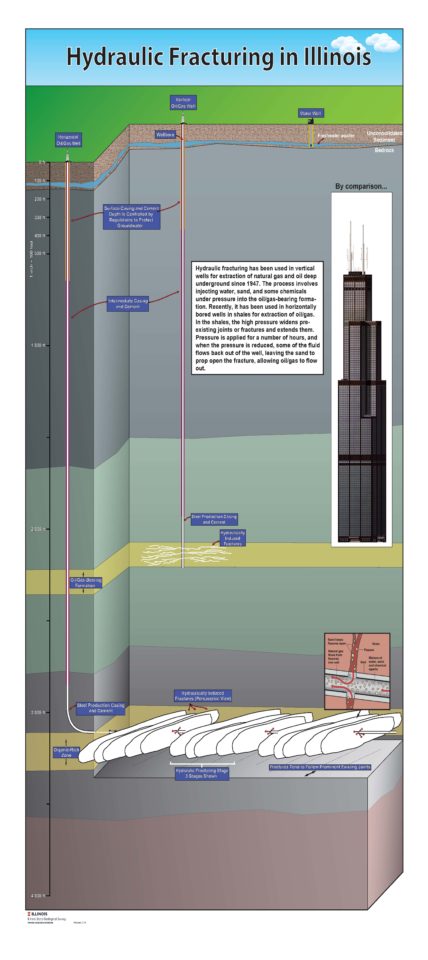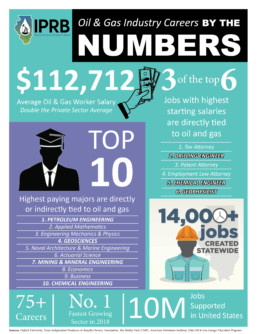Fact Checking the Petition to Ban Fracking in Illinois
The Illinois Coalition Against Fracking (ICAF) has been circulating a petition that calls for governor J.B. Pritzker to ban hydraulic fracturing (HF) in Illinois, including the low- and medium-volume HF that has been used to complete conventional vertical oil wells in the state since the 1950s.
So far, the ICAF has collected 893 signatures – more than 700 shy of its goal – and far less than the “thousands and thousands” of signatures a spokesman for coalition member Southern Illinoisans Against Fracturing Our Environment (SAFE) has claimed would be collected.
Despite the petition’s lack of success thus far, it remains essential to understand and communicate that the primary claims used in the document to argue for a HF ban are demonstratively false. It is also important to understand that the petition drive’s future success poses a serious threat to the Illinois oil production industry as a whole, considering roughly 75 percent of new wells in the Illinois Basin have to be hydraulically fractured to be commercially productive.
Here are the most egregious claims made in the petition followed by the facts. And unlike the claims made in the petition – the facts listed below are verified by links to reputable third-party sources.
CLAIM: “Whereas, the evidence is now irrefutable that fracking contaminates water, pollutes the air, threatens public health, harms local economies, decreases property values and fuels and exacerbates the climate crisis we face today;”
FACT: The weight of scientific evidence shows HF poses no significant threat to groundwater, does not result in air pollution that exceeds U.S. Environmental Protection Agency (EPA) air quality thresholds and is protective of public health. Academic research also shows HF has boosted local economies and property values near development, and has allowed the U.S. to lower its greenhouse gas emissions by making clean-burning natural gas more affordable and abundant.
- Groundwater: The current body of scientific research – which includes 15 peer-reviewed papers and eight reports commissioned by regulatory agencies – has examined more than 14,500 water wells across the United States and found no evidence of systemic water contamination issues attributable to HF. Many of the studies examined groundwater pollution and specifically ruled out HF as the cause of water issues. And notably, a landmark 2016 U.S. Environmental Protection Agency study concluded that, “[H]ydraulic fracturing operations are unlikely to generate sufficient pressure to drive fluids into shallow drinking water zones.”
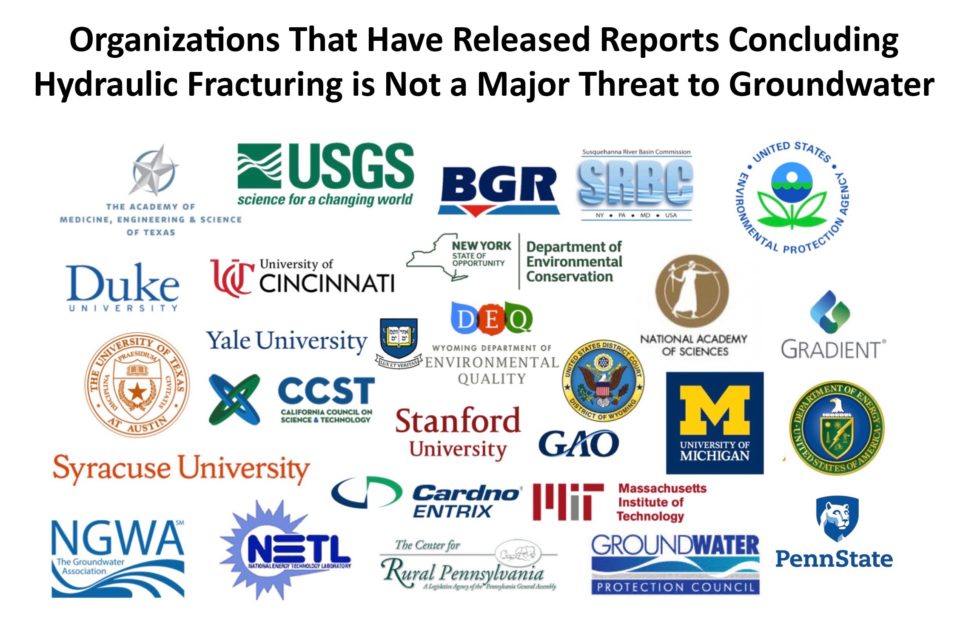
- Air Quality: Several state departments of environmental protection have installed air monitors at well sites and found that emissions during oil and natural gas development – and the HF process specifically – do not exceed public health thresholds. Activist researcher and executive director of the openly anti-oil and gas group Physicians Scientists & Engineers for Healthy Energy (PSEHE) Seth Shonkoff even admitted in a recent report that, “Air pollution near oil and gas production typically measures in concentrations within healthy air standards…” and that “it is unclear why ambient samples have failed to capture concentrations above health-based standards” near oil and gas development sites. In one of the most comprehensive reports based on actual air measurements to date, the Colorado Department of Public Health and Environment (CDPHE) took 5,000 air samples near oil and natural gas development. That report notes that the CDPHE “has not measured concentrations above what we expect would cause short- or long-term health impacts.”
- Public Health: There is no research to support the oft-repeated activist claim that the health of those who live near oil and gas development has been harmed by exposure to additives used in hydraulic fracturing fluid. A 2013 Gradient report states “there is not scientific basis” for the claim that HF fluids can contaminate groundwater from depth, also concluding, “[I]t is implausible that the fluids pumped into the target formation would migrate from the target formation through overlying bedrock to reach shallow aquifers.” Several state departments of environmental protection have installed air monitors at well sites and found that emissions during oil and natural gas development do not exceed public health thresholds (see above). The Colorado Department of Public and Environment and Pennsylvania Department of Health recently conducted a joint analysis of studies claiming to link health impacts to oil and natural gas development, concluding there is “insufficient weight of evidence” to link living near oil and natural gas production sites with poor health outcomes.
- Local Economic Impacts: A 2016 University of Chicago study finds HF is generating “enormous benefits” for communities with the most activity. The study finds average household incomes – “driven by increases in wages and other factors such as royalty payments from the drilling and local land owners” – are up seven percent in areas with the most development. The study also found that total employment was up 10 percent in areas with the most development, with annual net benefits of nearly $2,000 per household. Report co-author Michael Greenstone has said of the report’s findings: “In terms of the local economic impacts, I thought it was going to be big. … But the impact was bigger than I thought it was going to be.”
- Local Property Values: The above-referenced University of Chicago study also found that home values near unconventional oil and gas development actually increased six percent after development began.
- Greenhouse Gas Emissions: Experts agree that increased natural gas use – made possible by HF – is the primary reason the United States has reduced carbon dioxide (CO2) emissions more than any other country this century. The United Nations Intergovernmental Panel on Climate Change (IPCC) has noted, “A key development since AR4 is the rapid deployment of hydraulic fracturing and horizontal drilling technologies, which has increased and diversified the gas supply and allowed for a more extensive switching of power and heat production from coal to gas (IEA, 2012b); this is an important reason for a reduction of GHG emissions in the United States.” The U.S. Energy Information Administration (EIA) credits increased natural gas use in the United States for most of our country’s world-leading CO2 reductions over the past 15-plus years. The EIA finds that from 2005 to 2018, a shift to natural gas for electricity generation reduced emissions 57 percent more than the emissions reductions realized through renewables. The International Energy Agency (IEA) also credited natural gas for lowering U.S. emissions, noting that “Coal-to-gas fuel switching for power generation avoided 100 Mt of CO2 in advanced economies [in 2019] and was particularly strong in the United States due to record low natural gas prices.”
CLAIM: “Whereas, a transition to a renewable, efficient, and just energy system is impeded by the practice of fracking;”
FACT: HF has actually accelerated renewable energy growth by making natural gas – a necessary backup for intermittent renewable energy – far more abundant.
A 2016 National Bureau of Economic Research report found that renewable electricity generation has grown at roughly the same rapid rate as natural gas-fired electrical generation over the past two-plus decades. This can be explained by the fact that renewable sources of energy such as wind and solar are intermittent and require natural gas backup for times when the wind doesn’t blow and the sun doesn’t shine. As the paper notes, “… renewables and fast-reacting fossil technologies appear as highly complementary and that they should be jointly installed to meet the goals of cutting emissions and ensuring a stable supply.” Because the shale revolution has made natural gas abundant and affordable, renewable energy generation capacity has increased dramatically over the past decade. As former Clinton White House advisor Paul Bledsoe recently said of the shale revolution, “It’s a key reason renewables have grown so quickly.”
CLAIM: “Whereas any perceived financial benefit to the State of Illinois from allowing an expansion of oil and gas extraction in our State would be greatly exceeded by the harms that would ensue. Therefore, we, the undersigned organizations and individuals call upon Governor J. B. Pritzker to use his authority as governor of Illinois to impose an immediate ban on the granting of all new drilling permits for oil and natural gas that use any and all forms of hydraulic fracturing.”
FACT: Hydraulic fracturing is safely used to complete approximately 75 percent of new wells in the state. Banning HF would jeopardize more than 14,000 Illinois oil and natural gas industry jobs, hundreds of millions in annual state and local tax revenues and $3 billion in annual state economic impact.
Conclusion
To be clear, the ultimate objective of the ICAF is to ban all oil and natural gas development in the state, as evidenced by the group’s use of what it calls the “lifecycle” definition of HF, which encompasses every component of the oil and natural gas development process.
“Fracking is the entire above and below ground process of hydro-carbon extraction–from leases and well-site prep through waste disposal and well abandonment–where hydraulic fracturing is employed.”
Though the language in the petition appears to reference the actual hydraulic fracturing process in some parts of the document and the broad “lifecycle” definition elsewhere, it is more important to understand that the facts presented by IPRB apply to both the actual process of HF and broader oil and natural gas development in general. And those facts show that oil and natural gas development in the state has been conducted – and can continue to be conducted – in a way that protects the environment and public health while bringing undeniable economic benefits to the state.
What a Fracking Ban Would Mean For Illinois
 Likely Democratic presidential nominee Joe Biden promised “no new fracking” during Sunday night’s debate. Such a policy would have dire economic and environmental consequences for the country as a whole, considering 95 percent of new oil and natural gas wells have to be hydraulically fractured, aka “fracked,” to be commercially productive and increased natural gas use – made possible by fracking – is the primary reason the United States has reduced carbon dioxide emissions more than any other country this century.
Likely Democratic presidential nominee Joe Biden promised “no new fracking” during Sunday night’s debate. Such a policy would have dire economic and environmental consequences for the country as a whole, considering 95 percent of new oil and natural gas wells have to be hydraulically fractured, aka “fracked,” to be commercially productive and increased natural gas use – made possible by fracking – is the primary reason the United States has reduced carbon dioxide emissions more than any other country this century.
But what would a fracking ban mean to Illinois? Though it may not be as obvious as the national impact, a fracking ban would be devastating for the Land of Lincoln as well. Though there has been no high volume hydraulic fracturing conducted on horizontal wells in Illinois – the kind of development most associate with “fracking” – hydraulic fracturing has been safely used to complete thousands of the state’s vertical wells for decades and is used to complete roughly 75 percent of new Illinois vertical wells today. That is why a petition being circulated by the Illinois Coalition Against Fracking (ICAF) that calls for a ban all forms of fracking is a far bigger threat to the Illinois oil production industry than anything that’s being proposed on the national level. From the petition:
“Therefore, we, the undersigned organizations and individuals call upon Governor J. B. Pritzker to use his authority as governor of Illinois to impose an immediate ban on the granting of all new drilling permits for oil and natural gas that use any and all forms of hydraulic fracturing.”
To put it bluntly, three-quarters of potential new Illinois oil wells would potentially never be brought into production should the ICAF’s campaign prove successful. And even more importantly, while a president’s power to ban fracking is extremely limited, governors do sway significant authority – which is why talk of a state-wide ban is a far bigger threat than what is being proposed at the federal level.
A statewide fracking ban would obviously result in a huge economic blow to producing counties in the southern portion of the state, where the industry provides thousands of jobs and millions in annual tax revenues. And it would do nothing to help the state’s overall dire economic outlook, considering the oil production industry has a $3 billion annual economic impact and generates hundreds of millions in state tax revenues.
A fracking ban would effectively be a ban on almost all new oil and natural gas development – and “Keep It In the Ground” groups know that. This is one reason they use the boogeyman term “fracking” to describe anything oil and natural gas related. Though it might appear on the surface that these groups don’t understand the process they’re talking about, they are actually deliberately using the “fracking” label to consolidate the entire industry under a single unpleasant sounding term in an effort to achieve their ultimate objective – a total ban on oil and gas development.
As Daniel Raimi, senior research associate from Washington D.C. environmental think tank Resources for the Future, noted in his 2017 book “The Fracking Debate”:
“… opponents of the fossil-fuel industry writ large often refer to the ‘fracking industry’ instead of the ‘oil and gas industry,’ ‘fracking wells’ instead of ‘oil and gas wells,’ ‘fracking pipelines’ instead of ‘natural gas pipelines’ and so on…”
“If ‘fracking’ refers to the entire set of activities related to oil and gas development, it becomes easier for advocates to argue that ‘fracking’ is the cause of any high-profile case of pollution, whether or not those cases are the result of hydraulic fracturing itself. Pipeline rupture? Blame fracking. Local groundwater pollution from surface spills? Blame fracking.”
“And if the public believes that ‘fracking’ – rather than some more prosaic issue such as a pipeline leak or an oil spill at the surface – causes the damage to human health or the environment, it becomes easier to rally support behind a movement to ban fracking (meaning the discrete process of hydraulic fracturing).”
There are several examples of this tactic being employed by Illinois “Keep It In the Ground Groups.”
The ICAF refers to a “life cycle” definition of fracking as being “the entire above and below ground process of hydro-carbon extraction – from leases and well-site prep through waste disposal and well abandonment – where hydraulic fracturing is employed.” By this logic, one could use the terms “lifetime cycle” of spudding or the “lifetime cycle” of well logging instead, but those types of labels don’t incite negative connotations or garner any media attention.
Southern Illinoisans Against Fracturing Our Environment (SAFE) inaccurately defined fracking in 2018 as follows:
“Hydraulic fracturing, or fracking, is a mining technique that involves drilling deep into the earth, turning the drill bit 90 degrees and then drilling horizontally into rocks that contain little pockets of oil and gas…”
SAFE is obviously describing horizontal drilling, which is in no way shape or form hydraulic fracturing. For those unfamiliar with hydraulic fracturing, it is actually a well completion process that occurs after drilling has been completed and involves pumping fluid — typically 99.5 percent water and sand, with an additional mixture of chemical additives — into the target formation at pressure in order to open up small fractures and allow oil and gas to flow through the rock.
In another example of this deliberate conflation of horizontal drilling and fracking, SAFE describes in this blog post that the directional discovery well (Warren No. 1) drilled under Forbes Lake in Marion County in the early 2000s as being Illinois’ “first high volume horizontal well.”
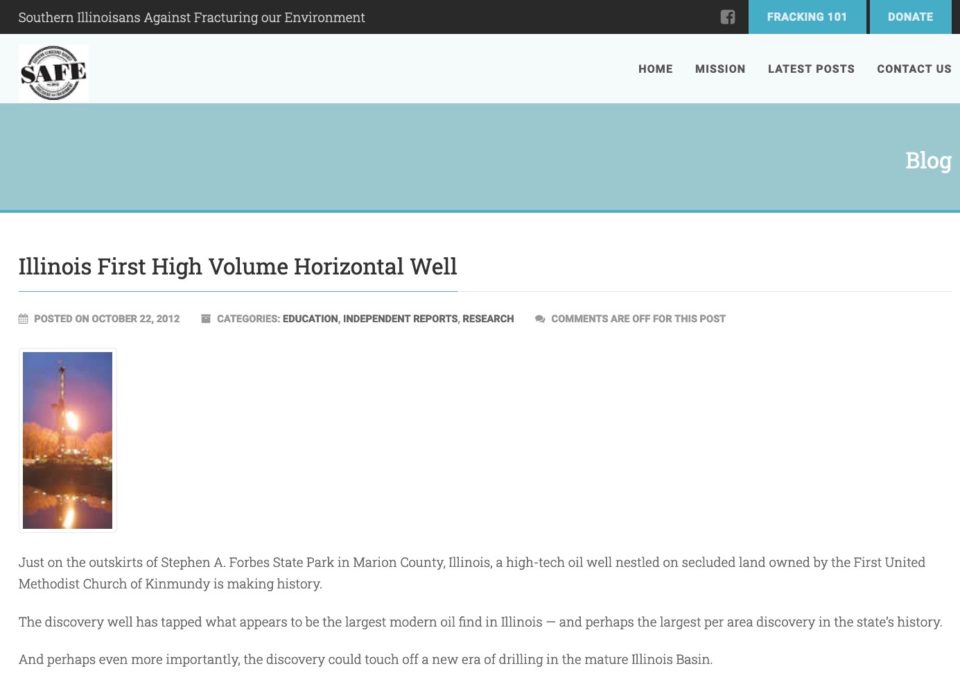 In reality, there was no high volume hydraulic fracturing – or any hydraulic fracturing at all, for that matter – conducted on this well.
In reality, there was no high volume hydraulic fracturing – or any hydraulic fracturing at all, for that matter – conducted on this well.
Though the manipulation of the proper definition of hydraulic fracturing is infuriating to some, it is more important to realize that the overall goal is to ban all oil and natural gas development, period. In today’s era of misinformation overload, the moniker “fracking” – like it or not – essentially translates “oil and gas.” And these groups are fully aware that a ban of the actual hydraulic fracturing process that they deliberately try to confuse the public and politicians about would, ultimately, undermine the entire industry.
The is why ICAF petition should be viewed not only as existential threat to any potential high volume hydraulic fracturing of horizontal wells in Illinois, but a threat to the state’s oil production industry in general.
Guest Column: US Economic Growth Has More to Do With Oil Boom Than Occupants of White House
The United States is enjoying an unprecedented 11th consecutive year of sustained economic growth. Predictably, both of the occupants of the White House during this time-span have claimed credit. But in reality, our historic run of economic prosperity can be traced to an American energy renaissance that has spanned both the Obama and Trump administrations.
Energy is the one thing that all Americans use. And with that fundamental reality in mind, advances in hydraulic fracturing, aka “fracking,” and horizontal drilling have allowed us to literally drill our way to lower energy prices and economic prosperity.
Since the Great Recession in 2009, U.S. oil production has more than doubled while domestic natural gas production has increased almost 50 percent. We are now the world’s biggest crude oil and natural gas producer and a net petroleum exporter. Not coincidentally, the Department of Energy reported in 2018 that average U.S. energy costs fell 34% from 2008 to 2016, dropping from record-high levels to a “record-low energy expenditure share” in less than a decade. Gasoline prices are about $1.50 below record high levels seen in 2008. Natural gas prices are at 20-year lows. And as NPR reported in August, “Cheap and abundant energy has fueled a resurgence in domestic manufacturing.”
Click here to read the full Southern Illinoisan guest column.
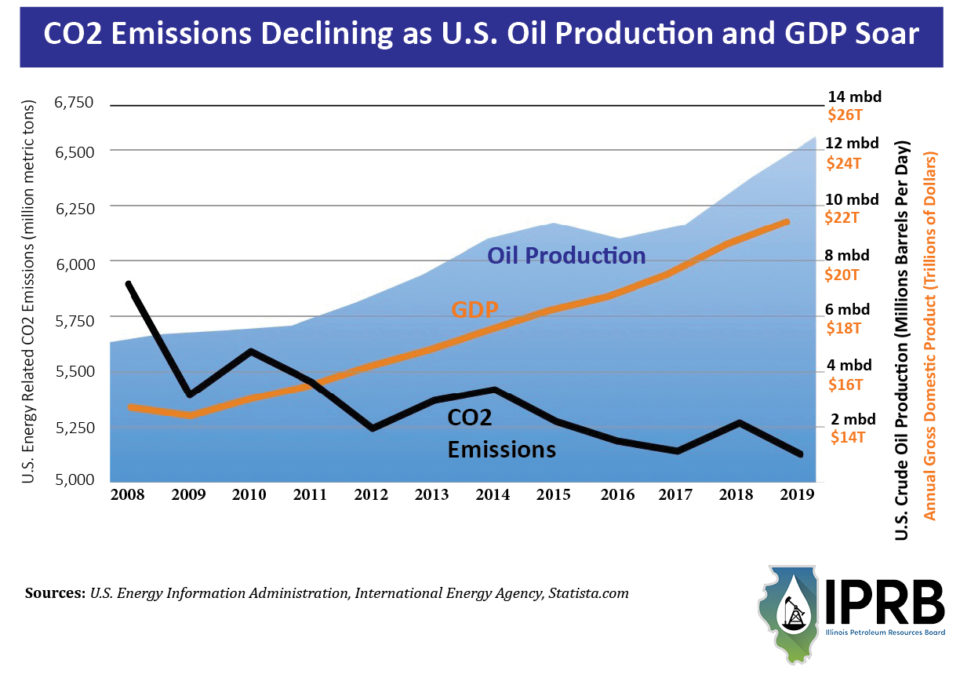
Illinois Oil Production Totaled 8.25 Million Barrels in 2019
Illinois crude oil production totaled 8,250,793 barrels in 2019, according to data compiled by the Illinois Petroleum Resources Board (IPRB) that is based on first-purchaser reports. Click here to view IPRB’s annual report.
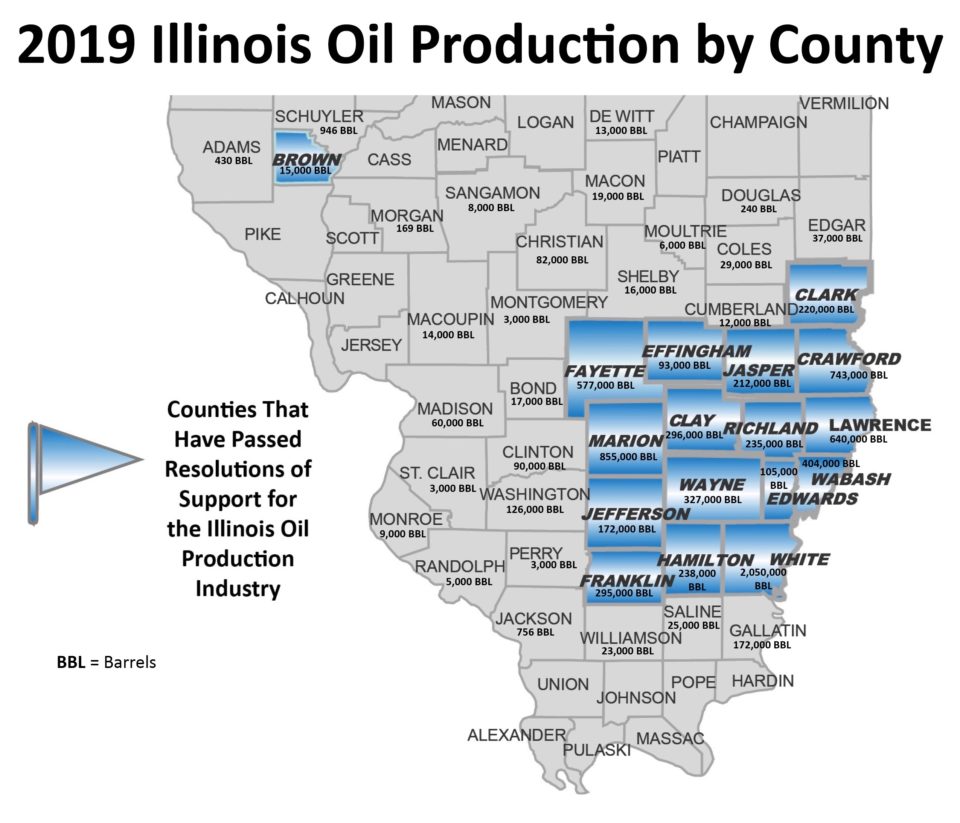 White County accounted for nearly a quarter of overall state production last year, as Illinois’ top-producing county surpassed the two million-barrel plateau with 2,049,462 barrels of production. That represents a 102,000-barrel (5.2 percent) increase from 2018 and is nearly twice the production the county had just a decade ago.
White County accounted for nearly a quarter of overall state production last year, as Illinois’ top-producing county surpassed the two million-barrel plateau with 2,049,462 barrels of production. That represents a 102,000-barrel (5.2 percent) increase from 2018 and is nearly twice the production the county had just a decade ago.
Marion (854,820 barrels), Crawford (743,027), Lawrence (639,774) and Fayette (577,505) counties rounded out Illinois' top-five producing counties in 2019.
Hamilton County saw the second-largest year-over-year production increase (38,100 barrels) in the state, vaulting past Richland County onto the top-10 list of producing counties with 238,416 barrels of production.
Franklin (7,152-barrel increase), Jefferson (3,939-barrel increase), Madison (2,729 increase), Brown (1,855 increase), Washington (1,687 increase), Moultrie (338 increase) and Schuyler (122 increase) counties also increased production from 2018 levels in 2019.
Overall state production declined 2.3 percent (194,295 barrels) from 2018 levels.
The state’s top-15 producing counties – White, Marion, Crawford, Lawrence, Fayette, Wabash, Wayne, Clay, Franklin, Hamilton, Richland, Clark, Jasper, Gallatin and Jefferson counties – once again accounted for 90 percent of production in the state. Fourteen of those counties – as well as Effingham and Brown counties – have passed Resolutions of Support for the Illinois Oil Production Industry in the past calendar year, formally acknowledging the importance of the industry to their local economies while also endorsing further growth of the industry in their counties.
Illinois oil production has ranged from 8.25 to 10.05 barrels since 2006, averaging 9.2 million barrels per year.
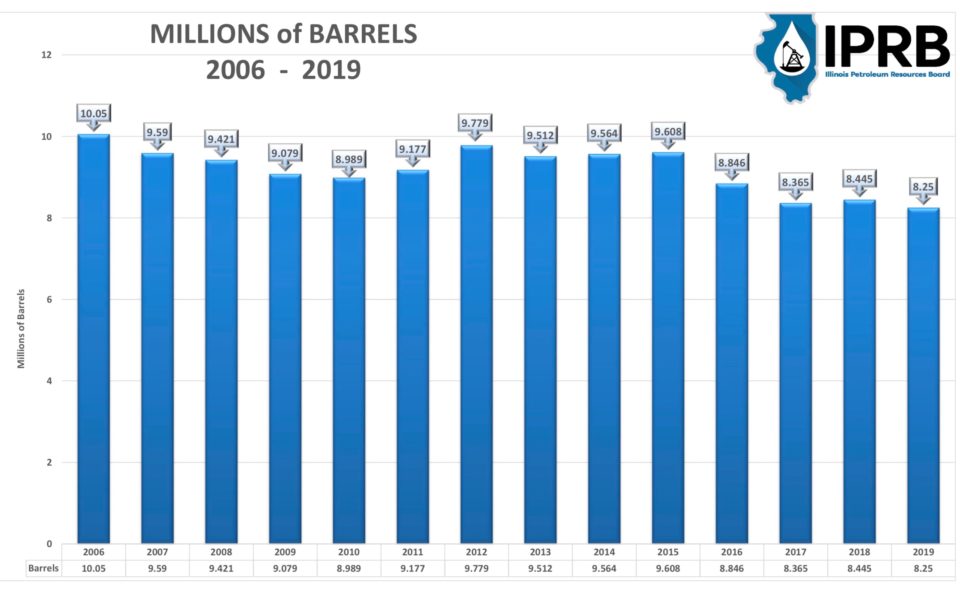
Report: Illinois Oil & Gas Reserves Generated $93.4M in Property Tax Revenue From 2007-2018
NOTE: This blog was updated with 2018 revenue on Jan. 23, 2020.
Many Illinoisans may not be aware that the state’s active oil and natural gas production leases are assessed and taxed as real estate, similar to property taxes paid on a residential home. All of the revenue collected from this tax – known as an ad valorem tax – stays at the local level and goes directly to support the areas where oil is produced, including counties, villages, townships, cities, and – most importantly – local schools.
An IPRB review of the latest Illinois Department of Revenue (DOR) data shows that Illinois oil reserves generated $93.4 million in ad valorem tax revenue from 2007 to 2018. IPRB details this revenue in a new report that can be downloaded here. (Note: Original August 2019 report was updated in January 2020 with 2018 revenue data.)
Typically, at least half of ad valorem property tax revenue is used to fund public education, while the remaining monies are used to fund various local public services. That fact noted, IPRB conservatively estimates that Illinois oil reserves generated at least $46.7 million in ad valorem tax revenue for schools in producing counties from 2007-2018. This revenue is all the more significant considering Illinois public schools were woefully underfunded by the state during this time frame, placing even more burden at the local level.
Ad valorem tax revenue from Illinois oil production has a particularly significant impact in major producing counties. DOR data show that ad valorem tax revenue in Illinois’ top-15 oil producing counties totaled $82.9 million from 2007-2018.
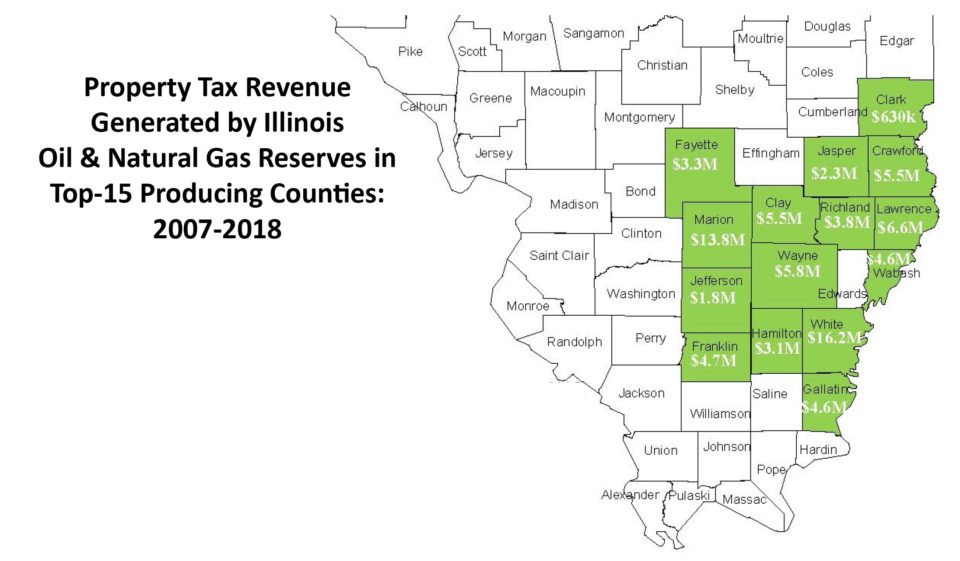 IPRB conservatively estimates that at least $41.45 million of that revenue went to public schools in those top-15 producing counties.
IPRB conservatively estimates that at least $41.45 million of that revenue went to public schools in those top-15 producing counties.
It is important to note that many of these counties have relatively small populations and are relatively poor compared to many other state counties and the state as a whole. In fact, all but one of Illinois’ top oil producing counties (Crawford) have poverty rates that are higher than the national average – adding even more significance to the ad valorem tax revenue generated by oil and natural gas reserves in these counties. Just two percent of Illinois' overall population resides in these top-15 producing counties, which are responsible for 90 percent of Illinois oil production.
Here are county-level breakdowns for Illinois' top-15 producing counties featured in IPRB’s report:
- White County
- Marion County
- Crawford County
- Lawrence County
- Fayette County
- Wabash County
- Wayne County
- Clay County
- Franklin County
- Richland County
- Clark County
- Jasper County
- Hamilton County
- Gallatin County
- Jefferson County
It is important to understand that these taxes are based on estimates of oil and gas reserves remaining in the ground, not oil and natural gas produced. The annual ad valorem tax bill that operators and royalty owners receive is also based on data that is over two years old. For example, ad valorem taxes paid in 2017 were based on a 2016 assessment of active leases that is calculated using 2015 production totals. There are also reductions for leases based upon lease age, secondary recovery methods used and production.
As complicated as the ad valorem tax calculation system may be, it is clear that these taxes are generating significant revenues in the communities where they operate, specifically for local schools.
Illinois Oil Reserves Generated $4.3M in Property Tax Revenue in 2018
Recently posted Illinois Department of Revenue (IDOR) data show that Illinois oil and natural gas reserves generated more than $4.3 million in property tax (ad valorem) revenue in 2018. Of that total, more than $3.9 million was generated in Illinois’ top-15 oil producing counties, where 90 percent of the state’s oil production occurs.

All of this revenue stayed at the local level and more than half went to fund K-12 public schools in the counties in which oil and natural gas reserves are located. That fact considered, IPRB conservatively estimates that at least $2.15 million of this revenue went to fund K-12 education in producing counties, including $1.95 million in the top-15 producing counties.
The rest of the $4.3 million in revenues went to fund county governments, road and bridge projects, local townships, local community college districts, public libraries, local hospitals, fire departments and park districts in producing counties.
Notably, oil and natural gas reserve property tax revenue collected in 2018 is based on 2017 assessments of active leases using 2016 production totals and average price of oil over a two-year period prior to the assessment date. The assessments are also based on estimated reserves that remain in the ground, not production. There are also assessment reductions for leased oil and natural gas reserves based on age, secondary recovery and methods of production.
A previous IPRB report released in the summer of 2019 finds Illinois oil and natural gas reserves generated more than $89 million in revenue from 2007-2017. Find out more about that report here.
2019 oil and natural gas reserve property tax revenues are not yet available on the IDOR website.
More Than Two Dozen Studies Find Fracking Poses No Significant Threat to Groundwater
“Keep It In the Ground” activists have claimed for years that hydraulic fracturing (“fracking”) poses an inherent threat to groundwater while deriding those who challenge the claim as “science deniers.” But there is actually no denying the fact that an overwhelming and growing body of scientific evidence shows fracking poses no significant threat to groundwater. No fewer than 29 scientific studies have reached that conclusion.

The current body of research – which includes 15 peer-reviewed papers and eight reports commissioned by regulatory agencies – has examined more than 14,500 water wells across the United States and found no evidence of systemic water contamination issues. Many of the studies examined groundwater pollution and specifically ruled out fracking as the cause. Two of the more than two dozen studies that find no evidence of groundwater impacts from fracking were even partially funded by anti-fracking groups.
Perhaps most notably, a 2016 U.S. Environmental Protection Agency study concluded that, “[H]ydraulic fracturing operations are unlikely to generate sufficient pressure to drive fluids into shallow drinking water zones.” The Obama administration’s EPA reached this conclusion even after expanding the definition of fracking to include virtually every oilfield activity imaginable, thus demonstrating the safety of the entire development process.
As Daniel Raimi, a senior research associate from environmental think tank Resources for the Future, noted in his 2017 book “The Fracking Debate”:
“To date, there is no research that indicates that the health of people living near oil and gas wells has been — or is likely to be — harmed by exposure to the chemicals mixed in with fracking fluid.”
The science is settled – fracking poses no significant threat to groundwater. Here is a review of the scientific research on the subject to date.
Peer-Reviewed Studies
- California Council on Science & Technology (2015): This peer-reviewed independent study by the nonpartisan, not-for-profit CCST and Lawrence Berkeley National Laboratory concluded: “We found no documented instance of hydraulic fracturing or acid stimulations directly causing groundwater contamination in California." (study link)
- Duke University (2017): Duke researchers evaluated water samples from 112 drinking water wells in West Virginia’s portion of the Marcellus Shale using state-of-the-art isotopic tracers to determine whether or not detected salinity, trace metals and hydrocarbons such as methane were from the fracking process. The researchers concluded, “Based on consistent evidence from comprehensive testing, we found no indication of groundwater contamination over the three-year course of our study.” The study was partially funded by the anti-fracking Natural Resources Defense Council (NRDC). (study link)
- Duke University/United States Geological Survey (2013): Duke and USGS researchers examined the water quality of 127 shallow domestic wells in the Fayetteville Shale and found no evidence of contamination, concluding: “This new study is important in terms of finding no significant effects on groundwater quality from shale gas development within the area of sampling. … Although preproduction water-quality data were lacking for the wells sampled for this study, geochemical data presented a well-defined pattern of geochemical evolution based on natural rock-water and microbially mediated processes, strongly suggesting that the resulting water quality is derived from these natural processes with no effects from gas-production activities.” (study link)
- Gradient (2013): Researchers from environmental risk research firm Gradient released two peer-reviewed studies finding no impacts from shale development. One report states, “Overall, there is no scientific basis for significant upward migration of HF fluid or brine from formations in sedimentary basins. Even if upward migration from a target formation to potable aquifer were hypothetically possible, the rate of migration would be extremely slow and the resulting dilution of the fluids would be very large…Given the overall implausibility and very high dilution factor, this exposure pathway does not pose a threat to drinking water resources.” (study link)
- National Energy Technology Laboratory (2014): In what the Associated Press called a “landmark study,” NETL researchers injected tracers into the hydraulic fracturing fluid in a well in Greene County, Pa., to track for any signs of possible migration. After 12 months of monitoring, the researchers found no signs of this happening. The report concluded: “Current findings are: 1) no evidence of gas migration from the Marcellus Shale; and 2) no evidence of brine migration from the Marcellus Shale.” (study link/alternate link)
- National Groundwater Association (2013): NGA researchers tested 1,701 water wells in northeastern Pennsylvania and found that “methane is ubiquitous in groundwater indicating that, on a regional scale, methane concentrations are not correlated to shale-gas extraction.” (study link)
- Penn State University (2018): PSU researchers analyzed 11,000 groundwater samples collected near 1,385 unconventional natural gas wells in Pennsylvania’s most heavily drilled Marcellus Shale county. The report states that the researchers found “no statistically significant deleterious impact on ten analytes related to the aggressive increase in development of unconventional shale-gas since 2008” and “an overall trend of improving water quality” in Bradford County “despite heavy Marcellus Shale development.” (study link)
- Stanford University (2015): According the report’s press release, “Using innovative techniques such as isotopic ‘tracer’ compounds that distinguish the source of chemicals in well water, [Lead researcher Rob] Jackson has not found evidence that frack water contaminants seep upward to drinking-water aquifers from deep underground.” (study link)
- Syracuse University (2015): SU researchers evaluated 11,309 randomly selected drinking water wells throughout northeastern Pennsylvania and concluded: “There is no significant correlation between dissolved methane concentrations in groundwater and proximity to nearby oil/gas wells.” (study link)
- University of Cincinnati (2018): UC researchers collected 180 groundwater samples before, during and after drilling was conducted in the most heavily drilled counties in Ohio’s Utica Shale over a four-year period. The researchers concluded, “We found no relationship between CH4 concentration or source in groundwater and proximity to active gas well sites” and noted “… our data do not indicate any intrusion of high conductivity fracking fluids as the number of fracking wells increased in the region.” Notably, the study was partially funded by the anti-fracking David & Sara Weston Foundation and the Deer Creek Foundation. (study link)
- United States Geological Survey (2017): USGS researchers randomly sampled 116 water wells across the Eagle Ford, Fayetteville and Haynesville shale plays and used chemical, isotopic, gas and groundwater-age tracers to thoroughly evaluate those samples. The researchers concluded that low concentrations of methane and benzene detected were likely naturally occurring and not attributable to shale development, and that “UOG [unconventional oil and gas] operations did not contribute substantial amounts of methane or benzene to the sample drinking-water wells.” (study link)
- University of Texas-Austin (2018): UTA researchers evaluated hundreds of water samples from 450 water wells across a 12-county study area located in Texas’s Barnett Shale. They concluded: “[H]ydraulic fracturing [fracking] has not affected shallow groundwater drinking sources in [the Barnett Shale] area.” (study link)
- University of Texas-Austin (2016): UTA researchers evaluated samples from 784 freshwater wells in the Barnett, Haynesville, Eagle Ford and Delaware Basin shale plays in Texas. They found that the presence of high dissolved methane concentrations in the wells “are likely natural” and not related to fracking. (study link)
- Yale University (2018): Yale researchers analyzed eight monitoring wells located in the Marcellus Shale in Susquehanna County, Pa., over a two-year period before, during and after seven shale gas wells were drilled, hydraulically fractured and brought into production. The researchers concluded, “Collectively, our observations suggest that [shale gas development] was an unlikely source of methane in our valley water wells.” (study link)
- Yale University (2015): Yale researchers found no indication of contamination from the fracking process itself in a study area located in the Marcellus Shale in northeastern Pennsylvania. As the researchers explain, “We found no evidence for direct communication with shallow drinking water wells due to upward migration from shale horizons.” (study link)
Government Agency Reports/Evaluations
- Groundwater Protection Council (2011): Based on an evaluation of Texas state data from 1993 to 2008 and Ohio state data from 1983 to 2007, the GWPC report concludes, “Neither state [Ohio and Texas] has documented a single occurrence of groundwater pollution during the site preparation or well stimulation phase of operations.” (report link)
- New York State Department of Environmental Conservation (2011): This NYDEC report states, “A supporting study for this dSGEIS concludes that it is highly unlikely that groundwater contamination would occur by fluids escaping from the wellbore for hydraulic fracturing. The 2009 dSGEIS further observes that regulatory officials from 15 states recently testified that groundwater contamination as a result of the hydraulic fracturing process in the tight formation itself has not occurred.” (report link)
- Susquehanna River Basin Commission (2016): The SRBC analyzed data from July 2008 until December 2013, a period of time when the Marcellus Shale industry was most active in Pennsylvania, and determined, “To date, the Commission’s monitoring programs have not detected discernible impacts on the quality of the Basin’s water resources as a result of natural gas development, but continued vigilance is warranted.” (report link)
- United States Department of Energy (2009): This DOE study, conducted in cooperation with the National Energy Technology Laboratory (NETL) and Groundwater Protection Council (GWPC) concludes, “[B]ased on over sixty years of practical application and a lack of evidence to the contrary, there is nothing to indicate that when coupled with appropriate well construction; the practice of hydraulic fracturing in deep formations endangers ground water. There is also a lack of demonstrated evidence that hydraulic fracturing conducted in many shallower formations presents a substantial risk of endangerment to ground water.” (report link)
- U.S. Environmental Protection Agency (2016): EPA’s six-year study found nothing to suggest that fracking is a serious risk to groundwater. While the agency made some wording changes to its previous topline finding that fracking has not caused “widespread, systemic” impacts to groundwater, the data in the report did not change from the draft version. The report states, “[H]ydraulic fracturing operations are unlikely to generate sufficient pressure to drive fluids into shallow drinking water zones.” (report link)
- United States Geological Survey (2014): The USGS and West Virginia Department of Environmental Protection’s Division of Water and Waste Management compared samples with historical water quality data in an area where drilling and hydraulic fracturing was occurring in the Monogahela River Basin during 2011-12. Researchers found that water quality in the area compared to historical data was not impacted by energy development: “The comparison of groundwater data from this study with historical data found no significant difference for any of the constituents examined and therefore warrant no further discussion.” (report link)
- United States Government Accountability Office (2012): The U.S. GAO consulted regulatory officials in eight states who explained, based on their own state investigations, that “the hydraulic fracturing process has not been identified as a cause of groundwater contamination within their states.” (report link)
- Wyoming Department of Environmental Quality (2019): A six-year-long WDEQ investigation determined that groundwater contamination near Pavillion, Wyo., is not connected to nearby hydraulic fracturing operations, debunking long-held claims to the contrary by anti-fracking groups. The report states: “Evidence does not indicate that hydraulic fracturing fluids have risen to shallow depths utilized by water-supply wells. Also, based on an evaluation of hydraulic fracturing history, and methods used in the Pavillion Gas Field, it is unlikely that hydraulic fracturing has caused any impacts to the water-supply wells." (report link)
Other Reports
- The Academy of Medicine, Engineering and Science of Texas (2017): This two-year study by TAMEST – which is comprised of academics from a wide range of universities, industry experts and state regulators – analyzed the overall impacts oil and gas development has had on Texas, including water quality, and concluded, “The depth separation between oil-bearing zones and drinking water-bearing zones in Texas makes direct fracturing into drinking water zones unlikely, and it has not been observed in Texas.” (report link)
- Cardno Entrix (2012): This study, focusing on water wells in the Inglewood, Calif., oil field concluded, “Before-and-after monitoring of groundwater quality in monitor wells did not show impacts from high-volume hydraulic fracturing and high-rate gravel packing.” (study link)
- The Center for Rural Pennsylvania (2011): CRP researchers evaluated water sampled from 233 water wells in proximity to Marcellus gas wells in rural regions of Pennsylvania in 2010 and 2011. Among these were treatment sites (water wells sampled before and after gas well drilling nearby) and control sites (water wells sampled though no well drilling occurred nearby). The report concludes, “In this study, statistical analyses of post-drilling versus pre-drilling water chemistry did not suggest major influences from gas well drilling or hydrofracturing (fracking) on nearby water wells, when considering changes in potential pollutants that are most prominent in drilling waste fluids.” (report link)
- German Federal Institute for Geosciences and Natural Resources (2016): In this study, German geologists used computer simulations to study what would happen to frack fluids when injected into the bedrock of the North German basin and found “… that the injected fluids did not move upwards into layers carrying drinking-water.” (study link)
- University of Michigan (2013): This report states that: “The often-postulated percolation upward of fracking water used in deep, long lateral well extensions to contaminate drinking water aquifers near the surface through the intervening impermeable rock formations is highly unlikely and has never reliably been shown to have occurred.” (study link)
- University of Michigan (2013): Based on meetings between the report’s authors and officials from Arkansas, Colorado, Louisiana, North Dakota, Ohio, Oklahoma, Pennsylvania and Texas, the report states there has been “… no report of groundwater contamination in these states was associated with hydraulic fracturing.” (report link)
Four GHG Reduction Options the ‘Keep It In the Ground’ Movement Opposes or Dismisses
Reducing carbon dioxide (CO2) emissions is priority No. 1 in the global effort to mitigate global warming. So it remains a bit mystifying that a vast majority of climate activists oppose or dismiss several proven CO2 reduction options in favor of a narrow set of deeply flawed policies that would rely almost exclusively on intermittent wind and solar energy to reduce emissions.
The most recent example of the folly of this philosophy is an independent fiscal watchdog report that slams New York state-level version of the Green New Deal, a plan that was heavily lobbied for by “Keep It In the Ground” groups.
Not only did the Citizens Budget Commission (CBC) report criticize New York’s win-and-solar focused plan as being unnecessarily costly for consumers, it noted the plan would be “counterproductive” to emission reduction targets. Why? Because of the state’s focus on renewables over nuclear, natural gas and the kind of “all-of-the-above” approach necessary to not only actually reduce emissions, but do so in a way that won’t devastate the economy.
The report underscores the fact that the “Keep It In the Ground” movement’s push to implement its preferred wind-and-solar-only solutions seem more driven by its war on fossil fuels than a desire to reduce CO2 emissions as much as possible. And amidst all the climate alarm sweeping the country, there remains a fundamental lack of understanding regarding the limitations of wind and solar energy – as well as a general lack of awareness of other energy sources and mitigation options that can be used alongside renewables to more effectively reduce emissions.
IPRB would like to take a few moments to take a closer look at four CO2 emission reduction measures that climate activists either wrongly overlook or outright oppose.
Natural Gas
Increased natural gas use is the No. 1 reason the United States leads the world in CO2 reductions this century. The fuel emits roughly have the carbon dioxide as coal when combusted and has become the top electricity generation fuel in the United States over the past decade.
In fact, the U.S. Energy Information Administration (EIA) has credited fuel switching to natural gas for electricity generation for 60 percent of U.S. power sector CO2 emission savings since 2005. Fuel switching to natural gas is also responsible for 57 percent more CO2 savings in the power sector than renewables during that time, as the following Energy In Depth graphic illustrates.
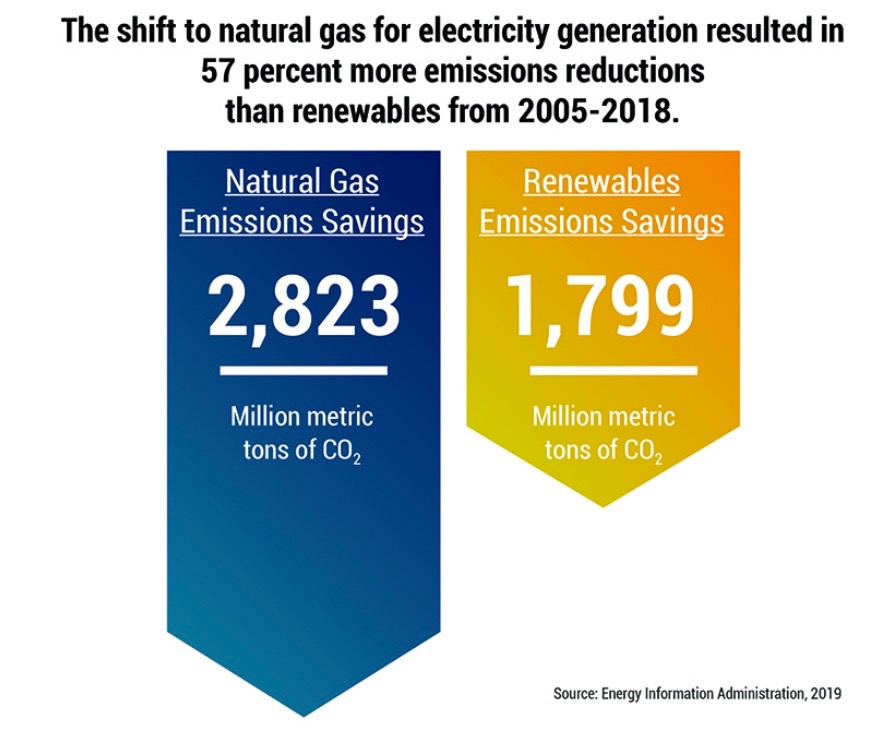
Overall United States energy-related CO2 emissions have declined 13 percent since 2005. Some “Keep It In the Ground” activists have claimed methane leaks from the natural gas supply chain wipe out natural gas’ climate benefits. But Breakthrough Institute climate scientist Zeke Hausfather has thoroughly debunked this narrative, noting that U.S. CO2 reductions remain in the 10 to 11 percent range since 2005 when the effects of methane leakage are taken into account.
Fuel switching to natural gas is a proven option to reduce CO2 emissions, period, and also serves as a necessary backup to intermittent wind and solar power generation, which cannot be currently stored at the level (and cost effectiveness) necessary to provide baseload power and meet peak demand. Nonetheless, “Keep It In the Ground” activists favor banning hydraulic fracturing – the technology that has made natural gas more abundant and affordable than any time in history.
Natural gas holds even more potential to reduce CO2 emissions when coupled with another technology that “Keep It In the Ground” activists suspiciously oppose.
Carbon Capture and Storage (CCS)
Carbon capture and storage (CCS) – the direct capture of carbon dioxide from power plants, industrial facilities, mobile emission sources and the atmosphere – is a rapidly developing technology that has been identified by the United Nations Intergovernmental Panel on Climate Change (IPCC) as being pivotal to reducing emissions and avoiding the worst impacts of climate change. However, the technology isn’t popular at all among many “Keep It In the Ground” purists, due to the fact that it would prolong fossil fuel use indefinitely.
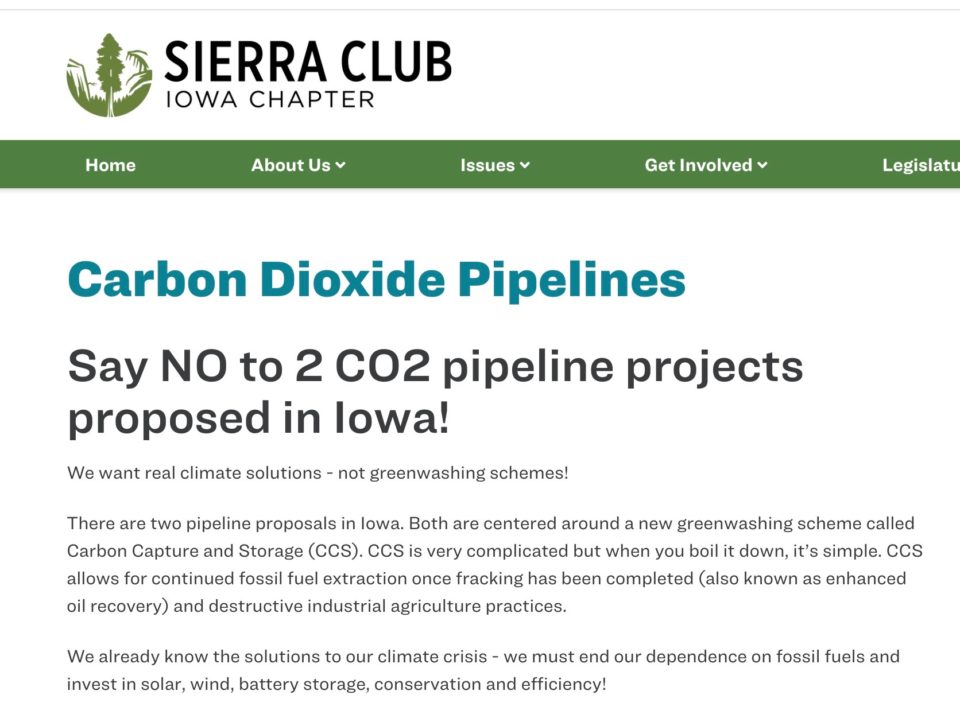
Interestingly, the primary reasons carbon CCS isn’t already widely used – cost-effectiveness – mirrors one of the key obstacles keeping wind and solar from being implementable on a large-scale basis. But a key breakthrough was made just last month that could go a long way toward solving the CCS affordability issue.
Researchers from the Massachusetts Institute of Technology (MIT) recently published a study detailing how a battery-like device can suck CO2 directly from the atmosphere and store it at a relatively low price ($50-$100 per ton of CO2).
Electro-swing adsorption for high efficiency carbon capture from Sahag Voskian on Vimeo.
Just as importantly, this potential large-scale CCS technology could be applied to automobiles and planes, and could also possibly be used for enhanced oil recovery (EOR), proving not only to be a key tool in addressing climate change but producing the oil the world will need for decades to come.
Even the Natural Resources Defense Council (NRDC) has called CO2-EOR a win-win-win for our environment, energy, and economy. CO2-EOR is currently responsible for 450,00 barrels of oil production per day in the United States and holds the potential to revive mature oil fields such as those that dominate the Illinois Basin.
A pilot CCS natural gas-fired power plant in Texas has also recently been labeled a “great success,” and developers are currently evaluating sites for a commercial version of the plant. Bloomberg also recently reported that a leading CCS company is planning to build a plant in Texas designed to remove one million tons of CO2 from the air annually (equivalent of 250,000 cars) at a cost of $100-$200 per ton removed. If the plant is successful, the company will build hundreds and eventually thousands of similar plants throughout the world. A recent Global CCS Institute report indicates nearly 2,000 such facilities will need to be built by 2040 in order to meet climate change mitigation targets.
Fortunately, a new peer-reviewed study finds there is enough potential underground CO2 storage to meet Paris climate agreement targets. So if costs continue to fall, CCS should be a viable tool to reduce CO2 emissions in the decades ahead.
Nuclear
Nuclear power generation emits no CO2 and currently represents 20 percent of the U.S. power generation mix. Though it doesn’t get nearly as much attention as wind and solar, nuclear energy has far outpaced those technologies in significantly reducing CO2 emissions from the power sector. In fact, as Forbes columnist Michael Shellenberger noted earlier this year that “the only green new deals that have ever worked were done with nuclear, not renewables.”
Shellenberger identifies France and Sweden as the only major nations that have decarbonized their power sectors. France gets 88 percent of its electricity from non-carbon sources, with 72 percent coming from nuclear, another 10 percent from hydro and just six percent from wind and solar. Similarly, Sweden gets 95 percent of its power from non-carbon sources, but 42 percent comes from nuclear, 41 percent from hydro and just 17 percent from wind, solar and other renewables.
Though nuclear energy isn’t perfect (no energy source is) it would certainly seem to be a viable option for a movement that characterizes global warming is an existential threat. However, a fact sheet that was released as part of the Green New Deal rollout calls for nuclear phase-out.
Reforestation
A recent peer-reviewed study shows that increasing the earth’s forests by an area the size of the United States would cut global CO2 by 25 percent. The study’s senior author boasted that his study “shows clearly that forest restoration is the best climate change solution available today” and would return CO2 levels to what they were 100 years ago.
Planting trees is also the most cost-effective CO2 emission mitigation option, with costs of just $15 to $50 per ton of carbon dioxide removed, according to a recent study by the National Academies of Sciences.
However, reforestation has not been prioritized Green New Deal advocates or the “Keep It In the Ground” movement. This could be traced to estimates that a 100 percent conversion to wind and solar energy could require as much as one-third of United States land space to be covered by solar panels and wind turbines. A massive increase in land use for rare earth mineral mining would also be required. Such an undertaking would obviously infringe upon any significant reforestation effort.
Conclusion
To be clear, wind and solar energy will no doubt be a major contributor to any and all efforts to reduce greenhouse gas emissions in the decades to come. However, they are not the panacea that many climate activists and proponents of the Green New Deal and the “Keep It In the Ground” movement make them out to be.
At the same time, a recent New York Times analysis concludes that even assuming aggressive greenhouse gas emission reduction policies are implemented throughout the world “the petroleum industry will have to find about 4.5 million, instead of seven million barrels a day of new production every year.” Even assuming 100 percent compliance with Paris climate agreement targets, 48 percent of global energy will come from oil and natural gas in the decades to come. Put plainly – the world is still going to need a lot of oil and natural gas for a long, long time.
That is why an all-of-the-above approach including natural gas, rapidly improving CCS technologies, nuclear and reforestation is the best path forward. The “Keep It In the Ground” agenda and dogmatic focus on 100 percent wind and solar energy is not.
Depth Deception: How Activists Mislead Students and Educators on Well and Hydraulic Fracturing Depths
The following cartoon-like depiction of the hydraulic fracturing (“fracking”) process is currently being distributed to West Virginia schools by a retired educator-turned-“Keep It In the Ground”-activist.
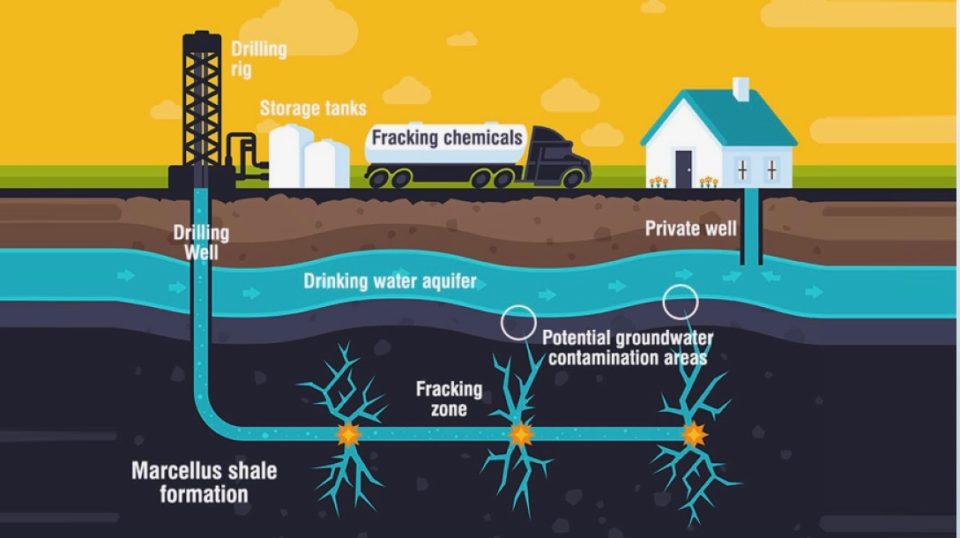
The depiction shows the “fracking zone” – the area where hydraulic fracturing treatments occur in a horizontal wellbore – as being just below the water table, with fractures nearly extending into the above drinking water aquifer.
This depiction could not be more misleading and is intended to perpetuate the myth that fracking – both of the high volume horizontal variety that occurs in places like Texas, Pennsylvania and North Dakota, and the vertical well application that has been widely used in Illinois since the 1950s – is an inherent threat to groundwater. A similarly inaccurate depiction was also circulated to schools in a 2017 issue of the publication Junior Scholastic.
The reality of typical hydraulic fracturing and oil and gas well depths is reflected in the following Illinois State Geological Survey (ISGS) graphic (click image to enlarge).
The ISGS graphic accurately shows that the depth in which hydraulic fracturing occurs on conventional horizontal wells in Illinois far exceeds the height of the 110-story Willis Tower in Chicago.
It also shows the depth in which high volume hydraulic fracturing of horizontal wells in Illinois’ New Albany Shale – a practice has yet to take place in the Land of Lincoln – would occur at even greater depths than conventional vertical wells.
Not only is hydraulic fracturing conducted at tremendous depths below freshwater aquifers, thousands of feet of impenetrable rock separate the production zones being fractured from the freshwater aquifers above. It is simply physically impossible to generate enough energy to create fractures that extend thousands of feet vertically into freshwater aquifers.
Even the U.S. Environmental Protection Agency’s landmark 2016 hydraulic fracturing study concluded that,
“[H]ydraulic fracturing operations are unlikely to generate sufficient pressure to drive fluids into shallow drinking water zones.”
A 2012 peer-reviewed paper by research firm Gradient concluded,
“[T]here is no scientific basis for significant upward migration of HF fluid or brine from tight target formations in sedimentary basins.”
A second peer-reviewed paper from Gradient, featured in the journal Geophysical Research Letters, echoed these findings. The study concluded:
“It is not physically plausible for induced fractures to create a hydraulic connection between deep black shale and other tight formations to overlying potable aquifers…”
That EPA study also notes that the median hydraulic fracturing treatment in the United States occurs 8,000 feet below the surface.
So, suffice it to say, the average K-12 student would never get the impression that fracking typically takes place thousands of feet below aquifers based on the graphic this particular activist chose to use.
The reality depicted in the ISGS graphic illustrates why no fewer than 31 scientific studies – including 17 peer-reviewed studies and nine reports commissioned by regulatory agencies – have concluded fracking is not a major threat to groundwater.
December 10, 2019
Oil & Gas Careers: High Paying and In Demand
Oilprice.com recently published a rather ominous article headlined “Oil Industry Faces Imminent Talent Crisis.” That headline was prompted by a survey by an energy recruitment company that found nearly half of the exploration and production firms that responded were “either quite worried or very worried about an impending talent crisis.”
The concern can be traced to a harsh reality with regard to millennials and their general attitudes toward the oil and gas industry: Young people believe we are quickly transitioning away from fossil fuels and that the future of the industry is bleak. As a result, fewer young people are pursuing oil and gas industry careers. But the facts simply do not support the impetus for this trend.
Oil and natural gas consumption is projected to increase by more than 20 percent over the next 30 years, which explains why oil and natural gas careers are not only in high demand – but pay twice the private sector average salary.
Here are some facts that young people entering the workforce should consider:
- The average oil and natural gas industry salary was $112,712 in 2018.
- Three of the top six highest paying majors are directly tied to the oil and gas industry.
- The top 10 highest starting salaries are in occupations directly or indirectly tied to oil and gas.
- The oil and gas extraction industry was the fastest growing sector in 2018.
- The U.S. oil and gas industry supports more than 10 million American jobs.
- There are more than 75 different careers in the oil and gas industry.
Contrary to popular public perception, the future of oil and natural gas careers is very bright. Check out IPRB’s new Oil and Natural Gas Careers “By the Numbers” infographic for more facts on oil and natural gas careers.
